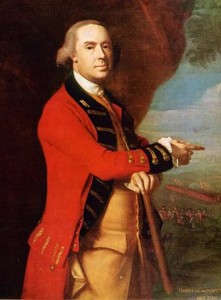
Gen Thomas Gage - Source: http:// media. photobucket. com/ image/ photo%20 general%20thomas%20 gage/ maggie6138/ maggie2/ maggie3/ marg2.jpg
Thomas Gage was the second son of the Viscount Gage. He was born in Firle, England in 1719 and died April 2, 1787. He entered the military in 1740 as an Aide de Camp to Lord Albemarle.
With Albemarle, Gage saw action in two of histories more famous engagements; the Battle of Fontenoy and Culloden. During this time he distinguished himself as an able leader.
In 1755 Gage was assigned to America. His unit was part of Braddock’s ill fated expedition to Fort Duquesne. Gage was seen as exhibiting patience and tact in diplomacy with the Native Americans over the issues of trade, communication and western boundaries which enabled him to move up the ladder of command.
On November 16, 1764 Gage was appointed Commander in Chief of all of America and head quartered in Albany New York. In this role he was almost immediately confronted with Pontiac’s Rebellion. As a result of Governor Penn’s inadequate response to the renewed hostilities between settlers and Native Americans on the frontier, Gage was faced with the Paxton Boys (1763) and Smith’s Rebellion in 1765. Smith’s Rebellion was the first armed resistance to British Military rule in America which led the British to abandon their garrisons in western Pennsylvania.
Gage’s inability to accurately understand America’s rising desire for independence marked the beginning of his down fall. His mistaken assessments began almost immediately with his appointment as Royal Governor of Massachusetts. In response to the Boston Tea Party he helped shape Parliaments hard line approach seen in the Intolerable Acts which closed the port of Boston until the lost tea was paid for. Instead of quelling American resentment and anger this act further inflamed it.
It was Gage who issued orders that included quartering troops in private homes. On April 18-19, 1775 he ordered a force to Lexington and Concord to destroy the colonists military stores which ignited the American Revolution. Gage’s last act in America was to order the June 17, 1775 attack known as the Battle of Bunker Hill. Because of criticism over heavy casualties Gage returned to England in October 1775. He was replaced by William Howe.
His critics continued to attack him for the defeat at Bunker Hill. Gage died at his home at Portland Place on April 2, 1787.
Sources:
http://en.wikipedia.org/wiki/Thomas_Gage
http://americanrevwar.homestead.com/files/gage.htm
http://www.u-s-history.com/pages/h1292.html